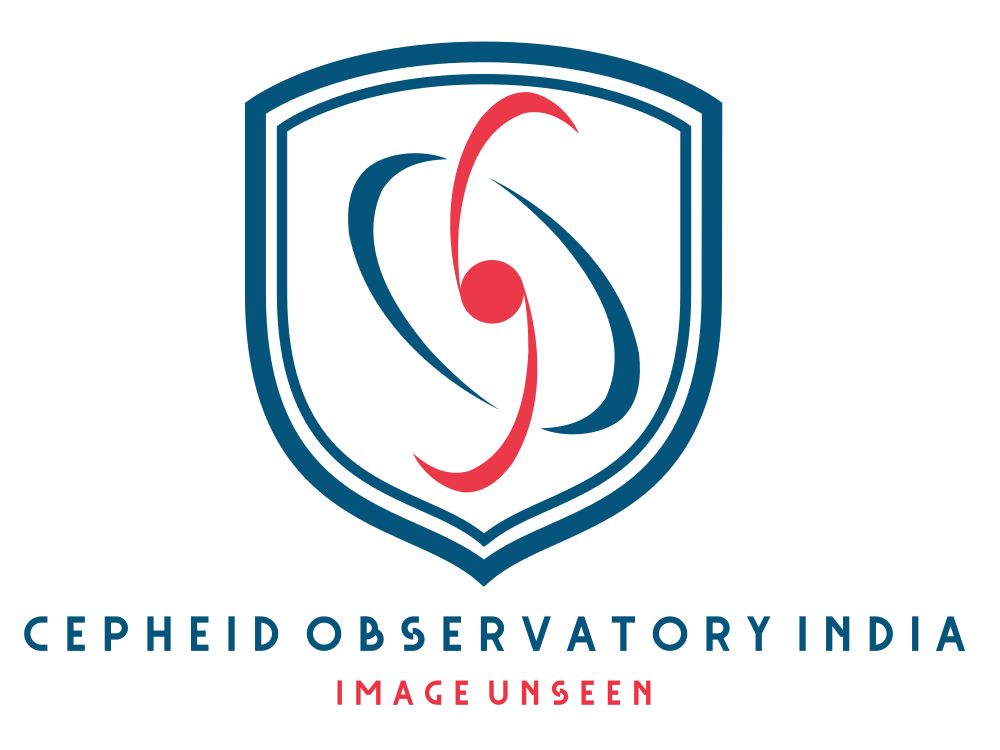Spectroscopic Identification by Remote Observation of Stars “SIROS” is on going project of spectroscopy.
We are happy to present some data as presentation.
Author: cepheids
Best Spectrophotometric Standards
Best spectrophotometric standards:
epoch mu a cosd mu d Class V Mag
LTT377 00 41 02.9 -33 44 06 1985 f 11.2
Feige 24 02 32 30.9 +03 30 51 1950 +0.083 +0.010 DAwke 12.42
EG21 03 10 22.1 -68 39 28 1985 DA 11.4
G191B2B=EG247 05 01 31.5 +52 45 52 1950 +0.10 -0.0873 DAwk 11.78
GD71 05 49 34.79 +15 52 37 1950 + -0.1898 DA1 13.03
LTT2415 05 56 24.2 -27 51 26 1985 12.2
EG54 07 40 19.52 -17 24 41 2000 +1.136"/y -0.52" DF 12.98
LTT3218 08 41 33.6 -32 56 55 1985 DA 11.8
EG63 08 47 29.6 -18 59 50 2000 -0.12"/y -0.05"/y DB 15.55
LTT3864 10 31 33.1 -35 33 03 1985 f 12.1
Feige 34=EG71 10 36 41.1 +43 21 50 1950 sdO 11.24
GD153 12 54 35.21 +22 18 09 1950 -0.1898 DA1 13.35
HZ 43 =EG98 13 14 00.7 +29 21 49 1950 -0.149 -0.0813 DAwk 12.91
HZ 44 13 21 19.1 +36 23 38 1950 -0.062 +0.031 sdO 11.67
EG274 16 23 33.7 -39 13 48 2000 DA 11.0
LTT7379 18 36 26.2 -44 18 37 1985 G0 10.2
HD 192281 20 10 46.8 +40 07 01 1950 O5f 7.54
BD+284211=J256 21 48 57.1 +28 37 48 1950 sdOp 10.56
LTT9239 22 52 40.88 -20 35 26 2000 f 12.0
Feige110=EG158 23 17 23.5 -05 26 22 1950 +0.003 -0.003 sdO 11.88
OK standards:
Feige 25 02 36 00.0 +05 15 16 1950 B6V 12.01
Hiltner 600 06 42 37.2 +02 11 25 1950 B1V 10.42
Feige 56 12 04 13.8 +11 56 55 1950 B5p 11.11
Feige 92 14 09 41.3 +50 21 07 1950 Bp 11.62
BD+33 2642 15 50 02.9 +33 05 49 1950 B2 IVp 10.88
BD+40 4032 20 06 40.0 +41 06 15 1950 B2 III 10.45
The first set contains O stars without much Balmer absorption plus
faint southern standards from the list of Stone & Baldwin 1983, MN 204, 347.
The second set is mostly B stars that have a bit of Balmer absorption
and are usually OK.
from Link: https://www.cfa.harvard.edu/~dfabricant/huchra/standards.specp
Optical Spectroscopy of Comet C/2014 Q2 (Lovejoy) from MIRO
Authors: Kumar Venkataramani, Satyesh Ghetiya, Shashikiran Ganesh, U. C. Joshi, Vikrant K. Agnihotri, K. S. Baliyan
Abstract: Spectra of comet C/2014 Q2 (Lovejoy) were taken with a low resolution spectrograph mounted on the 0.5 m telescope at the Mount Abu Infrared Observatory (MIRO), India during January to May 2015 covering the perihelion and post-perihelion periods. The spectra showed strong molecular emission bands (C2, C3 and CN) in January, close to perihelion. We have obtained the scale lengths for these molecules by fitting the Haser model to the observed column densities. The variation of gas production rates and production rate ratios with heliocentric distance were studied. The extent of the dust continuum using the Af-rho parameter and its variation with the heliocentric distance were also investigated. The comet is seen to become more active in the post-perihelion phase, thereby showing an asymmetric behaviour about the perihelion.
https://arxiv.org/abs/1607.06682
Submitted 22 July, 2016; originally announced July 2016.
Comments: Accepted for publication in MNRAS
Journal ref: MNRAS 463, 2137, 2016
Optical photometry of recurrent nova M31N 2008-12a
We report optical photometry and astrometry observation of recurrent nova M31N 2008-12a (ATel #12179, #12181, #12182) on 2018 November 7.82 UT. The observation was obtained using the 0.28m Schmidt-cassegran telescope, Cepheid’s Observatory, Rawatbhata, India. The UCAC4 and PRISMv10 Catalog are used for astrometry and photometry. The V and R band magnitudes are estimated to be 18.91 +/- 0.27 and 19.06 +/- 0.37 respectively. The coordinates for the nova is RA: 00h45m28.819s, DEC: +41°54’10.05” from astrometry. We plan to monitor this interesting nova on regular basis in coming time.
Additional BVRI photometry of recurrent nova M31N 2008-12a
We report our follow-up photometric observations of recurrent nova M31N 2008-12a. The nova brightened by ~3 mag after discovery in one day and declined back to 20-21 mag in ~ 4 days after discovery (ATels #12177, #12179, #12181, #12182, #12189, #12190, #12195, #12200, #12203). The observations were obtained using the 0.28m Schmidt-Cassegrain telescope, Cepheid’s Observatory, Rawatbhata, India. The UCAC4 and PRISMv10 Catalog are used for photometry. Nova was below the detection limit (> 19.5) in our next observations taken on 2018 November 09.77 UT .
DATE(2018) EXP(s) BAND MAG
Nov 8.78 UT 1800 I 19.34 +/- 0.55
Nov 8.80 UT 1800 R 19.28 +/- 0.39
Nov 8.83 UT 1800 V 19.43 +/- 0.43
Nov 8.85 UT 1800 B 19.30 +/ -0.58
ExoClock Project: An open platform for monitoring the ephemerides of Ariel targets with contributions from the public
Authors: Anastasia Kokori, Angelos Tsiaras, Billy Edwards, Marco Rocchetto, Giovanna Tinetti, Anaël Wünsche, Nikolaos Paschalis, Vikrant Kumar Agnihotri, Matthieu Bachschmidt, Marc Bretton, Hamish Caines, Mauro Caló, Roland Casali, Martin Crow, Simon Dawes, Marc Deldem, Dimitrios Deligeorgopoulos, Roger Dymock, Phil Evans, Carmelo Falco, Stephane Ferratfiat, Martin Fowler, Stephen Futcher, Pere Guerra, Francois Hurter , et al. (24 additional authors not shown)
Abstract: The Ariel mission will observe spectroscopically around 1000 exoplanets to further characterise their atmospheres. For the mission to be as efficient as possible, a good knowledge of the planets’ ephemerides is needed before its launch in 2028. While ephemerides for some planets are being refined on a per-case basis, an organised effort to collectively verify or update them when necessary does not exist. In this study, we introduce the ExoClock project, an open, integrated and interactive platform with the purpose of producing a confirmed list of ephemerides for the planets that will be observed by Ariel. The project has been developed in a manner to make the best use of all available resources: observations reported in the literature, observations from space instruments and, mainly, observations from ground-based telescopes, including both professional and amateur observatories. To facilitate inexperienced observers and at the same time achieve homogeneity in the results, we created data collection and validation protocols, educational material and easy to use interfaces, open to everyone. ExoClock was launched in September 2019 and now counts over 140 participants from more than 15 countries around the world. In this release, we report the results of observations obtained until the 15h of April 2020 for 119 Ariel candidate targets. In total, 632 observations were used to either verify or update the ephemerides of 83 planets. Additionally, we developed the Exoplanet Characterisation Catalogue (ECC), a catalogue built in a consistent way to assist the ephemeris refinement process. So far, the collaborative open framework of the ExoClock project has proven to be highly efficient in coordinating scientific efforts involving diverse audiences. Therefore, we believe that it is a paradigm that can be applied in the future for other research purposes, too.
https://arxiv.org/abs/2012.07478
Submitted 14 December, 2020; originally announced December 2020.
GJ 3470 c: A Saturn-like Exoplanet Candidate in the Habitable Zone of GJ 3470
Phillip Scott, Bradley Walter, Quanzhi Ye, David Mitchell, Leo Heiland, Xing Gao, Alejandro Palado, Burkhonov Otabek, Jesus Delgado Casal, Colin Hill, Alberto Garcia, Kevin B. Alton, Yenal Ogmen, Vikrant Kumar Agnihotri, Alberto Caballero
We report the discovery of a new exoplanet candidate orbiting the star GJ 3470. A total of three transits were detected by OKSky Observatory: the first one on December 23, 2019, the second one on February 27, 2020, and the third one on May 3, 2020. We estimate an average transit depth of 0.84 percent and duration of 1 hour and 2 minutes. Based on this parameter, we calculate a radius of 9.2 Earth radii, which would correspond to the size of a Saturn-like exoplanet. We also estimate an orbital period of 66 days that places the exoplanet inside the habitable zone, near the orbital distance at Earths equivalent radiation. Another twelve potential transits that do not belong to GJ 3470 b are also reported. Despite our candidate for GJ 3470 c still has to be confirmed by the scientific community, the discovery represents a turning point in exoplanet research for being the first candidate discovered through an international project managed by amateur astronomers.
https://arxiv.org/abs/2007.07373
Submitted 14 July, 2020; originally announced July 2020.
Magnitude to Flux Density conversion
The following graphs shows the conversion of flux densities w.r.t. magnitudes. The magnitude range is selected based on UCAC4 catalog from 0 to +16. The Y axis represents the energy flux in the units of (erg cm-2 sec-1 A-1) w.r.t respective U B V R I magnitudes. The graphs plotted both in Log and Linear scales.
Log Scale:
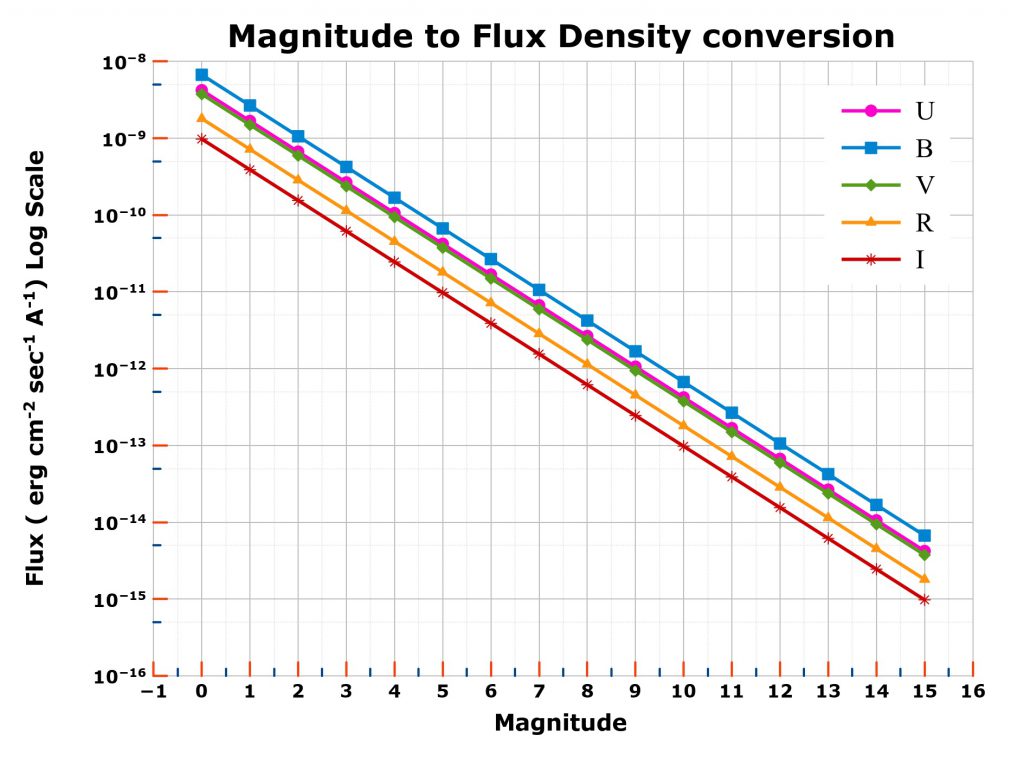
Linear Scale:
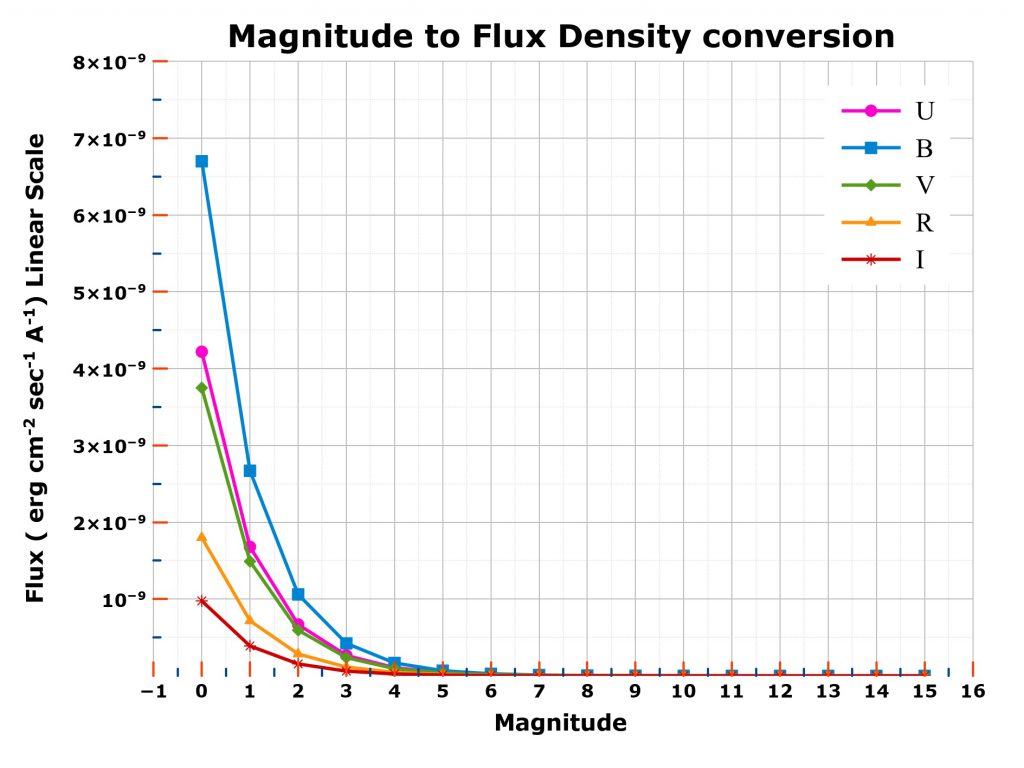

Comet 156P/Russell-LINEAR
Image:
Object: Comet 156P/Russell-LINEAR
DATE-OBS: 2020-12-31T14:17:27
EXPTIME: 3600.00 (seconds)
SUBFRMS: 30
OBJCTRA: 01 10 14.294
OBJCTDEC: +26 13 33.181
Instrument:
Catalog: UCAC4
Bessell (B): +*.*, Bessell (V): +*.*
Bessell (R): +13.7, Bessell (I): +*.*
CCD: ATIK-383L+
FILTERS: R
TELESCOPE: C11, 1623.0mm
PRiSMv10, Astrometrica
Site:
ORIGIN: Cepheid Observatory, India, Vorion Scientific, India
SITELAT: +24:55:00:00
SITELONG:+75:33:58:99
Observers:
V.K.Agnihotri, B. Kumar,
S. Mahawar, K.Vora
Remark:
NIL
End
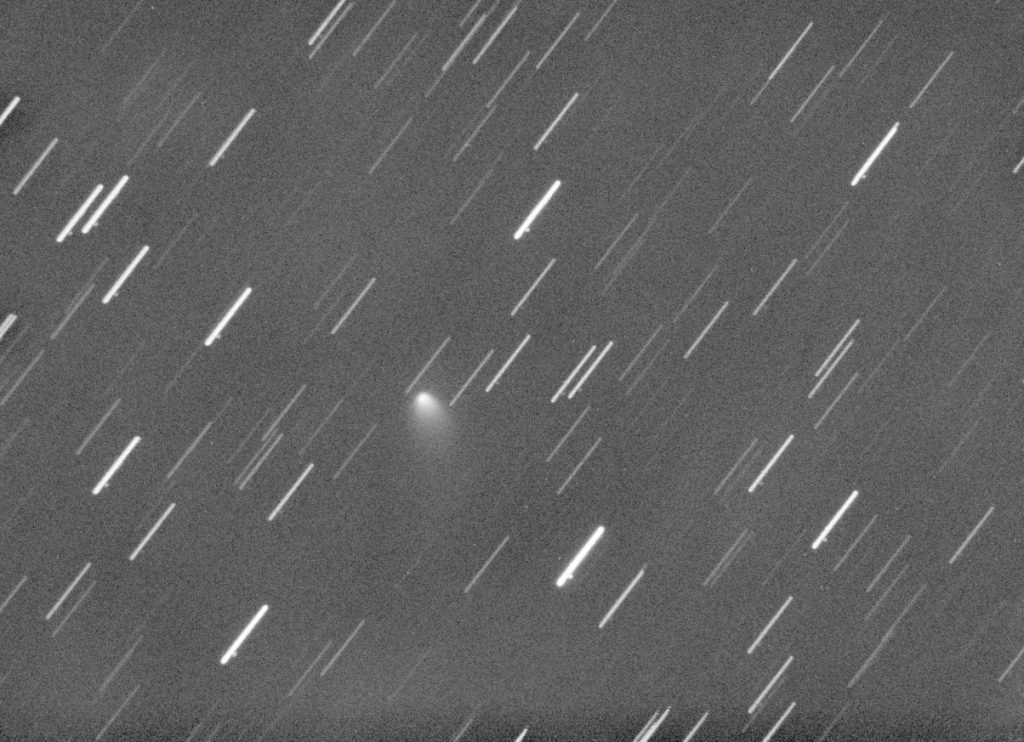
Comet C/2013 X1 PanSTARRS
Comet C/2013 X1 PanSTARRS, Dated: 2016.01.08 UTC: 13:59:29
Tele: 0.28m/f6.3, Exp: 100x 30 secs, Atik383L+mono, no filter
Center (RA, Dec): (358.957, 18.590)
Center (RA, hms): 23h 55m 49.722s
Center (Dec, dms): +18° 35′ 23.565″
Size: 34.7 x 26.1 arcmin
Radius: 0.362 deg
Pixel scale: 1.24 arcsec/pixel
Orientation: Up is -1.51 degrees E of N
Cepheids Astronomy Group, RBT, India
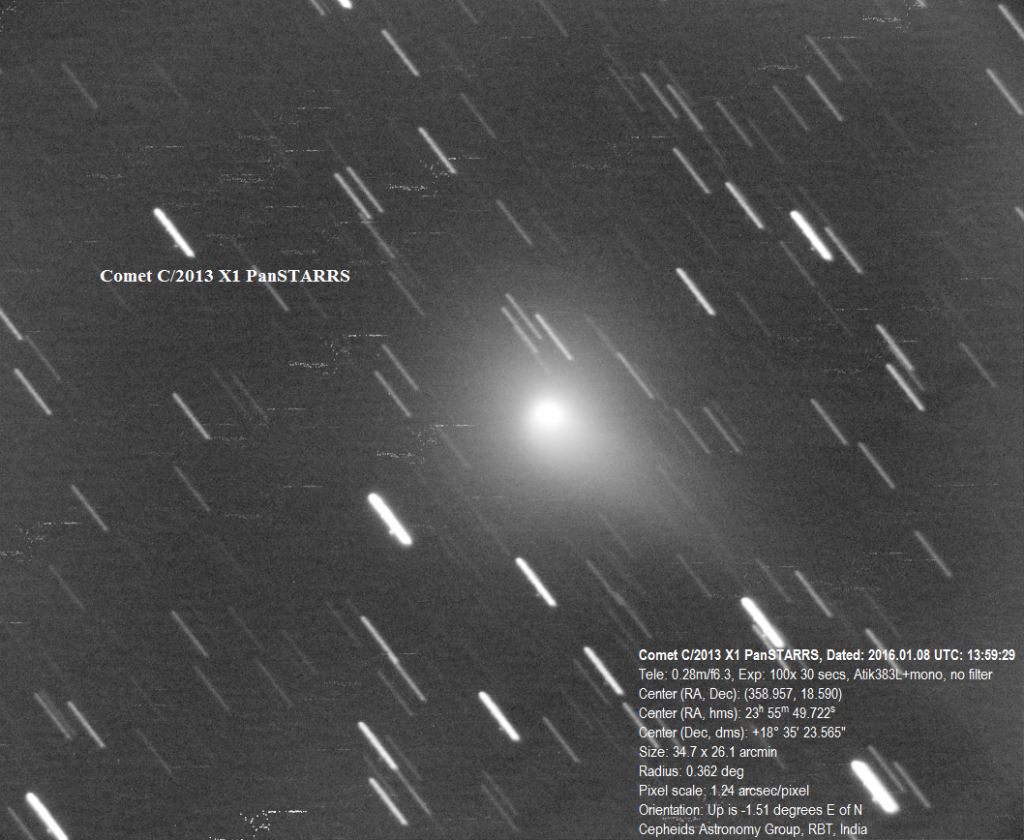
C/2015 V2 Johnson
C/2015 V2 Johnson ‘2017-02-05T23:01:17’
Tele: C11/0.28m/f10.0, KAF8300 (3326X2504, 5.4µMX5.4µM)
Filter: XAF-GCE125 565rb (http://www.omegafilters.com/565rb.html)
Binning: 3X3 (16.21µmX16.21µm)
Tele field of view: 22.10acrminx16.66acrmin
Plate scale: 1.1859 arcsec/pix
Angle: 87.91 Deg
Exp: 9X90secs
Guiding: PHD2/ICX825
OBJCTRA: 15 43 37
OBJCTDEC: +44 49 15
APT Tool, Maximdl, CCDstack, DS9
Cepheids Astronomy Group,RBT, India.

